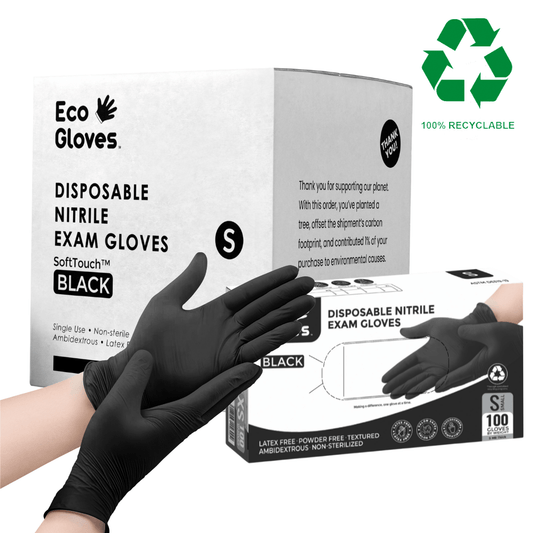Best Disposable Gloves For Food Handling: Safety And Compliance Tips
Eco GlovesFood safety is paramount in the food industry. Thousands of foodborne illnesses occur yearly due to improper handling, cross-contamination, or inadequate hygiene. Disposable gloves have become a crucial component in the food industry, not only as a barrier against contaminants but also as a means to ensure that food handling practices comply with health regulations. However, with various types of disposable gloves available, choosing the right pair can be a challenge.
This article covers FDA-compliant gloves for food handling, the benefits of using specific materials, and essential tips for selecting the best gloves for food handling. Moreover, as more companies and consumers look for environmentally responsible products, we’ll explore eco-friendly food prep gloves options that help to reduce waste and lessen the environmental footprint of disposable gloves.
Topics Covered
- Why Use Disposable Gloves for Food Handling
- FDA Requirements And Safety Standards For Food Handling Gloves
- FDA Compliance for Food Handling Gloves
- Best Glove Materials for Food Prep: Nitrile, Vinyl, Latex, PE, and Sustainable Options
- Key Features of Food-Safe Gloves
- Eco-Friendly Gloves In The Food Industry
- Prioritize Safety And Sustainability In Food Handling
- Key Takeaways: Food Handling Disposable Gloves
- Frequently Asked Questions
Why Use Disposable Gloves for Food Handling
Disposable gloves play a vital role in maintaining hygiene and preventing cross-contamination in food handling and preparation. When used correctly, they act as a barrier between hands and food, reducing the risk of transferring bacteria, viruses, and other pathogens. This is especially critical when handling raw meat, seafood, or ready-to-eat items, as these foods are prone to contamination that can cause foodborne illnesses.
In commercial food service settings, wearing gloves also helps businesses comply with local and federal health regulations, such as FDA guidelines, which mandate proper hand hygiene practices.
Beyond safety, gloves also instill confidence in customers, demonstrating a commitment to cleanliness and professionalism. However, it’s essential to ensure gloves are replaced frequently and not used as a substitute for proper handwashing.
FDA Requirements And Safety Standards For Food Handling Gloves"
The Food and Drug Administration (FDA) plays a significant role in setting safety standards for disposable gloves used in food handling. By following these requirements, food businesses can ensure they’re providing a safe and compliant environment. 
FDA Compliance for Food Handling Gloves
According to the FDA, food-contact gloves must meet specific regulatory standards to prevent contamination. Here’s a breakdown of the primary FDA requirements:
1. Materials Used in Gloves
The FDA mandates that gloves for food handling be made from FDA-compliant materials. These materials should not release harmful substances or alter food's taste, smell, or appearance. Nitrile, vinyl, polyethylene, and latex are typically common FDA-compliant materials. Biodegradable options like plant-based nitrile and compostable gloves also meet FDA standards, adding an eco-friendly aspect to food safety.
2. Powder-Free Requirement
The FDA prohibits powdered gloves in food handling and healthcare due to concerns that airborne powder particles could contaminate food and potentially cause allergic reactions. Therefore, food-grade disposable gloves must be powder-free to ensure the highest safety standards.
3. Thickness and Durability
While the FDA doesn’t mandate specific thicknesses for food-grade gloves, too-thin gloves may rip easily, compromising hygiene. A thickness of around 2-3 mils is typically adequate for food handling, providing flexibility without sacrificing durability. Heavier tasks may require gloves of up to 5 mils.
4. Single-Use and Disposal
The FDA requires that food-handling gloves be disposable and single-use. This rule minimizes the risk of cross-contamination. Gloves should be replaced frequently after handling raw meat, fish, or other allergens.
Compliance with FDA requirements is vital for any food business, as it reduces contamination risks and supports public health. Non-compliance endangers customers and can lead to legal consequences, fines, and a loss of business reputation. Moreover, understanding the types and standards of gloves the FDA allows helps make more informed purchasing decisions, prioritizing safety and quality.
Best Glove Materials for Food Prep: Nitrile, Vinyl, Latex, PE, and Sustainable Options
Choosing the correct type of glove for food handling depends on the specific tasks, potential allergens, and environmental considerations. Let’s explore the various types of materials and their unique benefits in food handling.

1. Nitrile Gloves
Nitrile gloves are widely favored in the food industry due to their durability, puncture resistance, and flexibility. Made from synthetic rubber, nitrile is an excellent option for people with latex allergies. Here are some of the critical benefits of nitrile gloves:
-
Durability and Resistance: Nitrile is resistant to oils, fats, and chemicals, making it ideal for food preparation involving greasy or raw ingredients. Nitrile gloves are typically available in various thicknesses, from 3 to 5 mils, which offer adequate protection for most food handling tasks.
- Eco-Friendly Glove Alternative: Nitrile gloves were traditionally not biodegradable. However, advancements have led to accelerated biodegradable nitrile and plant-based compostable options of eco-friendly gloves, which meet FDA standards and decompose faster, and more readily.
2. Vinyl Gloves
Vinyl gloves are another popular choice due to their cost-effectiveness. However, they are generally less durable than nitrile and may need to be more suitable for heavy-duty tasks. Here’s what vinyl gloves offer:
-
Affordability: Vinyl gloves are often more budget-friendly, making them a common choice in settings where gloves are frequently changed.
- Food-Safe: FDA-compliant vinyl gloves are suitable for handling food, although they may be less resistant to punctures than nitrile. Thicker vinyl gloves around 3-4 mils may be better suited for tasks that require added durability.
3. Polyethylene Gloves
Polyethylene gloves are lightweight, often transparent, and used in low-risk tasks. They are best suited for situations requiring frequent glove changes, such as serving ready-to-eat foods.
-
Lightweight and Affordable: Polyethylene gloves are generally less expensive and are typically used for quick, single-use applications in food service.
- Eco-friendly Glove Alternative: Some polyethylene gloves are now available in compostable versions made from PLA or similar accelerated compostable materials, reducing environmental impact by being made from plant-based materials and allowing them to break down faster in landfills.
4. Latex Gloves
Though effective for food handling, latex gloves pose a risk for people with latex allergies. Here’s what they bring to food safety:
-
Good Flexibility and Fit: Latex gloves provide excellent dexterity and are preferred in high-precision applications.
- Allergen Concerns: Given the prevalence of latex allergies, these gloves may be less commonly used in large-scale food services. Latex-free alternatives, like nitrile, are often preferred.
Key Features of Food-Safe Gloves
Not all disposable gloves are suitable for food handling, so understanding their key features is crucial to making the right choice. When selecting gloves for cooking or food handling, it is important to consider these factors:
-
Material: Food-safe gloves should be made from FDA-compliant materials, such as nitrile, vinyl, polyethylene, or polylactic acid, which are free from harmful chemicals that could leach into food.
-
Durability: Durability is essential, especially when handling wet or greasy items, so the gloves should resist tearing and provide a snug fit to allow for dexterity and comfort.
-
Textured or Non-textured Grip: Textured surfaces can improve grip, making them practical for tasks like cutting or handling slippery ingredients.
-
Color: Different color gloves are a smart choice in busy kitchens, as they help workers quickly identify gloves for different tasks, reducing the risk of cross-contamination.
-
Allergies or Skin Sensitivities: For those with sensitive skin or allergies, latex-free options such as nitrile or compostable bioplastic gloves ensure both safety and comfort.
- Eco-Friendliness: Consider eco-friendly gloves that are accelerated biodegradable, compostable, or recyclable to support sustainability efforts.
To quickly help you figure out how to choose the best disposable gloves for food safety, use our checklist below:

© 2024 Eco Gloves. All rights reserved. Visit www.ecogloves.co for more information.
Eco-Friendly Gloves In The Food Industry
The demand for sustainable solutions in the food industry is increasing as businesses look to reduce their environmental impact. Traditional disposable gloves contribute to landfill waste, but eco-friendly gloves offer several benefits.
Environmental Advantages
Disposable gloves are essential in the food industry, but they often end up in landfills after use. Eco-friendly options, such as compostable or biodegradable gloves, help address this issue by breaking down more quickly than conventional gloves. Biodegradable gloves can decompose in a fraction of the time of traditional options, significantly reducing their environmental impact.
Health and Safety Benefits
Eco-friendly gloves made from plant-based materials and sustainable sources reduce waste and eliminate potential toxins that may leach into food. For example, some biodegradable gloves are free from PVC, BPA, and phthalates, which are potentially harmful. Using safer materials and eco-friendly gloves contributes to a cleaner and safer food-handling environment.
Meeting Consumer Expectations
As consumers become more environmentally conscious, businesses can appeal to this shift by using sustainable products. A Nielsen survey found that 66% of global consumers are willing to pay more for environmentally responsible brands, which extends to food services. By using eco-friendly gloves, businesses can improve customer perception, meet consumer expectations, and contribute to a sustainable future.
Consider biodegradable or compostable options if your business aims to reduce its environmental footprint.
Prioritize Safety And Sustainability In Food Handling
Choosing suitable disposable gloves for cooking and food handling isn’t just about compliance; it’s about ensuring the safety of your customers, meeting consumer expectations, and minimizing environmental impact. You can create a safer, more sustainable food service environment by using FDA-compliant gloves that meet your specific needs—durability, comfort, or eco-friendliness.
Eco Gloves provides many sustainable gloves for food safety, including compostable and biodegradable gloves for food handling.
To explore eco-friendly gloves that align with FDA standards and contribute to a healthier planet, check out our sustainable gloves here. Make a positive impact today by choosing sustainable, high-quality gloves for your food handling needs.
Key Takeaways: Food Handling Disposable Gloves
- FDA-compliant, powder-free gloves are essential for preventing contamination and meeting food safety regulations.
- Nitrile gloves offer superior durability, chemical resistance, and allergy-safe performance for most food handling tasks.
- Vinyl gloves are cost-effective for light tasks, while polyethylene gloves are best for quick, frequent changes.
- Latex gloves provide excellent dexterity but can trigger allergic reactions—latex-free options are safer in most settings.
- Color-coded gloves help reduce cross-contamination in busy kitchens.
- Eco-friendly glove options, including biodegradable and compostable materials, support sustainability while maintaining compliance.
👉 Shop Eco Gloves’ food-safe glove collection for compliant, durable, and eco-conscious solutions for your kitchen.
Frequently Asked Questions
-
What makes a glove FDA-compliant for food handling?
It must be made from FDA-approved materials that are safe for direct food contact and free from harmful contaminants.
-
Why can’t powdered gloves be used for food handling?
Powder can contaminate food and potentially cause allergic reactions, which is why the FDA prohibits their use in food service.
-
What’s the best glove material for handling raw meat?
Nitrile gloves are durable, resistant to oils and fats, and provide a secure fit for handling raw meat and seafood.
-
Are biodegradable gloves safe for food handling?
Yes, as long as they are FDA-compliant and designed for food contact. Eco Gloves offers biodegradable and compostable options.
-
Should gloves be color-coded in food service?
Yes—assigning specific colors to different food tasks helps prevent cross-contamination.
Further Reading
- Disposable Nitrile Gloves: A Durable, Latex-Free Solution for All Industries
- Biodegradable Disposable Gloves: A Step Towards Sustainability in Industrial Workplaces
- How to Choose the Best Disposable Gloves for Cleaning

















